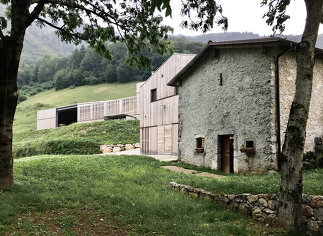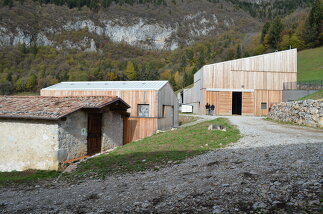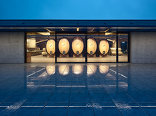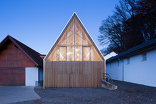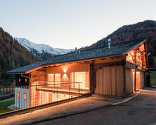Bauwerk
SUSTAINABILITY
Social added value at local level
Like other piers, the municipality of Oltressenda Alta suffered during 1900 from a powerful flow of emigrants. Today the average age of the residents is high; the few inhabitants, if not employed in the industries of the valley floor, live off a production of cheese sold locally. Many second homes are occupied a few weeks a year. The creation of a new farm, as well as upgrading an ancient district whose historical and affective value is shared by the inhabitants of the municipality, is in this context generative of new economic, social and cultural dynamics. The managers are young people coming from different urban contexts who have decided to set their working and family life around the project.
With the start-up of the farm holiday, a flow of tourists is expected to benefit from other local accommodation facilities (with which the farm is already in contact). Already now, the company sells its products together with other local products thanks to innovative systems for the context (social network, e-commerce) on a market that also extends to the cities of Bergamo and Milan. The new farm has also participated in 2014 in the opening of a shop located at a lower altitude, in the center of the country, for the sale of cheese and wine of local producers. Finally, the farm is also a destination for educational visits by schoolchildren.
The new production activity is proportionate to the mountain reality in which it is inserted, in order to be able to optimally and sustainably exploit the resources of the territory. The expected number of animals (about 30) is such as to be able to satisfy the food needs by using the hay produced by cutting the surrounding pastures (about 9 hectares), fertilized through the wastewater of the animals themselves. Finally, the size of the stable makes it possible to combine the other functions of the farm with livestock farming, with a view to ensuring that the managers' dwellings can coincide
Ecological Sustainability
Landscape/soil:
The new project has provided for the maximum possible concentration of functions within a single building. Soil conservation is a priority for the farm as the land and on which the stable was built are the pastures under management on the farm itself.
The height at which the barn floor has been set tries to optimize the volume to be excavated, in order to change as little as possible the original conformation of the land.
The creation of the stable in a sloping terrain has required the realization of an important excavation. Already during the design phase, a plan of excavations and landfills was designed, to limit the disposal of the excavated material as much as possible, using the extracted material to partially reshape the topography of the ground.
In addition to the creation of some dry stone walls, typical of the area, built with the larger aggregates from the excavations, the consolidation downstream of the stable was carried out with a system of reinforced grasses, studied by Ing Ivan Carrara and naturalist Glauco Patera.
Installations:
With the start-up of the farm holiday, the company will install a biomass (wood chips) thermal power plant that will produce all the energy needed for heating and DHW. The wood chips will be produced by the company as a valorisation of the waste from the cleaning of the woods and care of the edges of the mowing lawns. A district heating network between the buildings in the historic centre has already been installed and connected to the boiler room, which now consists of a LPG system that will be replaced.
The company has set up a system for the production of photovoltaic energy on the roof of the stable (1.5 Kwh/a total with an existing photovoltaic system of 9 square meters).
In addition, with the start-up of the farm holiday, it is planned to upgrade the photovoltaic system (1.2 - 1.4 kw,) exclusively functional to the farm holiday activity, i.e. not aimed at the production of renewable energy transferable on the market. The 1,200 - 1,500 kwh/year produced are estimated to be able to cover the fixed consumption connected to the operation of the agritourism (operation of cells and refrigerators, emergency lighting, video surveillance, internet connection, etc.). The peaks in electricity consumption related to the actual operation of the agriturismo will be covered by electricity drawn from the network. The system will be installed on the roof of the new stable.
Building materials:
The cladding system of the barn and dairy facades has been studied in depth by the designers in order to meet both criteria of economy and integration into the landscape. Untreated larch planks were used which, over time, take on a silvery-grey colour, with different shades depending on the exposure to the sun, to recall the local stone. The alternation of 9 and 18 cm planks, following a module that is repeated along the entire length of the façade, guarantees a more lively rhythm to the surfaces of the façade, accentuated by the horizontal cuts that mark the position of the frames and allow the use of planks of a maximum length of 4 m, according to industrial production standards. This system also makes it possible, along the sides of the barn, to guarantee the necessary lighting and ventilation, simply by spacing some of the planks. The planks are fixed dry on wooden crossbars, the latter hanging from the supporting structure.
Water:
The stable has a system of internal eaves and rainwater recovery in an underground tank of about 4 mc. The recovered water is used for the irrigation of the pastures and for watering the livestock.
With the start of the agritourism, the farm will build an underground tank of about 10 mc for the recovery of rainwater collected from the roofs of the building; the rainwater will be used for the maintenance of the greenery surrounding the building intended for agritourism and for washing the building itself.
Social Sustainability
The initiator of the entrepreneurial project is Giacomo Perletti, a graduate in agriculture and winner, in 2010, of a municipal tender for the management of some buildings of the district and its land, which were then in a state of semi-abandonment. Giacomo's wish, now in partnership with Matteo Trapletti and Giovanni Pizzamiglio, all young people under 35 years of age, was to set up a farm to restore cattle breeding and dairy farming. The program combines a production linked to the local tradition, in terms of breed and number of animals, type of products and practice of summer transhumance in the mountain pastures, with the use of innovative technologies.
The value of a nascent company for the local society has been recognized not only by the municipality, which has always supported the project, but also by the Orobie Bergamasche Park Authority, on whose border the Contrada is located. The Authority has financed part of the works, also acting as an intermediary for financing by the Cariplo Foundation (ARCOrobie 1 and 2 project), and has installed a Park Centre in one of the buildings of the Contrada. This Centre has the vocation of a place for meetings, exhibitions, educational activities that have as their theme the preservation and revitalization of mountain territories. The district has also hosted a course on the restoration of rural buildings organized by the Scuola Edile di Bergamo and the Soprintendenza ai Beni Culturali of the province of Bergamo and Brescia. The demonstration site was led by architect superintendent Gaetano Puglielli and restorer Davide Ferrari.
Economic Sustainability
The companies that worked on the stable, dairy and restoration project come from the province of Bergamo. The only exception is the company that designed the stable equipment (Wolf System). It was preferred, in this field, to rely on a company of excellence in the sector. The restoration of the stone buildings has also become an opportunity to organize a course organized by the Superintendence and Building School of Bergamo, to instruct local workers in the treatment of the many stone buildings in the valley.
The new production activity is in proportion to the mountain reality in which it is inserted, in order to be able to optimally and sustainably exploit the resources of the territory. The number of animals foreseen, therefore, is such as to be able to satisfy the food needs by using the hay produced from the cutting of the surrounding meadows, fertilized through the wastewater of the animals themselves. Finally, the size of the stable makes it possible to combine animal husbandry with the other functions of the farm, so that in the future the managers' dwellings can coincide with the site of the production complex.
In addition, the project has been directed towards opening up new activities that allow economic sustainability on the current market. An integral part of the farm will therefore be the agritourism, including accommodation and catering spaces, as well as rooms for teaching and small conferences.
The company is a positive factor for the entire community:
- it triggers new tourist dynamics: new visitors, also linked to educational activities of schools in the province of Bergamo or interested in the architectural project (the district has hosted students from the Faculty of Architecture of Innsbruck, Prof. Robert Veneri).
- triggers new commercial dynamics: the farm sells its own products and those of other local producers not only on site but also in various cities in Lombardy (through e-commerce or agreements with shops and restaurants). Moreover, in 2014 and also thanks to the participation of the company, a shop was opened in the municipality of Oltressenda for the sale of local products.
Energiesysteme: Fernwärme, Heizungsanlage aus biogenen Brennstoffen, Photovoltaik
Materialwahl: Holzbau, Mischbau, Stahlbau
Ansprechpartner:in für die Projektdaten: nextroom
Akteure
ArchitekturBauherrschaft
Tragwerksplanung
